Chapter 8
soil health, Plant health, and Pests
There are few farms in this or any country that are not capable of great improvement.
—luCius d. davis, 1830
SOIl PROPERTIES AND THEIR INTERRElATIONSHIPS
aggregates may break apart and cause the soils to have
Healthy soils occur when their biological, chemical, and
few pore spaces for air exchange. Plants will grow poorly
physical conditions are all optimal (figure 8.1), enabling
in a soil that has degraded tilth even if it contains an
high yields of crops. When this occurs, roots are able to
optimum amount of nutrients. Therefore, to prevent
proliferate easily, plentiful water enters and is stored
problems and develop soil habitat that is optimal for
in the soil, the plant has a sufficient nutrient supply,
plants, we can’t just focus on one aspect of soil but must
there are no harmful chemicals in the soil, and beneficial
approach crop and soil management from a holistic
organisms are very active and able to keep potentially
point of view.
harmful ones in check as well as stimulate plant growth.
A soil’s various properties are frequently related to
PlANT DEFENSES, MANAgEMENT
one another, and the interrelationships should be kept
PRAcTIcES, AND PESTS
in mind. For example, when a soil is compacted, there
Before discussing the key ecological principles and
is a loss of the large pore spaces, making it difficult
approaches to soil management, let’s first see how amaz-
or impossible for some of the larger soil organisms to
ing plants really are. They use a variety of systems to
move or even survive. In addition, compaction may
defend themselves from attack by insects and diseases.
make the soil waterlogged, causing chemical changes
Sometimes they can just outgrow a small pest problem
such as when nitrate (NO –
3 ) is denitrified and lost to the
by putting out new root or shoot growth. Many plants
atmosphere as nitrogen gas (N2). When soils contain a
also produce chemicals that slow down insect feed-
lot of sodium, common in arid and semiarid climates,
ing. While not killing the insect, it at least limits the
Photo courtesy Judy Brossy
77
Building SoilS for Better CropS: SuStainaBle Soil ManageMent
chAPter 8 soil health, Plant health, and Pests
biological properties
extensive biodiversity
plentiful beneficial
organisms
low pest pressure
Healthy
Soil
good tilth
surface structure
porous and stable
no subsoil layers
pH near neutral
restricting roots
optimal nutrient levels
good aeration,
no harmful chemicals
water storage,
physical
low levels of salts
properties
chemical
drainage
properties
Figure 8.1. Optimal chemical, biological, and physical properties promote healthy soils.
damage. Beneficial organisms that attack and kill insect
eggs that deactivates the caterpillar’s immune system.
pests need a variety of sources of nutrition, usually
Without the virus, the eggs would not be able to develop
obtained from flowering plants in and around the field.
and the caterpillar would not die. There is also evidence
However, when fed upon—for example, by caterpillars—
that plants near those with feeding damage sense the
many plants produce a sticky sweet substance from the
chemicals released by the wounded leaves and start
wounds, called “extra-floral nectar,” which provides
making chemicals to defend themselves even before they
some attraction and food for beneficial organisms.
are attacked.
Plants under attack by insects also produce airborne
Leaves are not the only part of the plant that can
(volatile) chemicals that signal beneficial insects that
send signals when under attack that recruit beneficial
the specific host it desires is on the plant. The benefi-
organisms. When under attack by the western corn root-
cial insect, frequently a small wasp, then hones in on
worm—a major pest—the roots of some varieties of corn
the chemical signal, finds the caterpillar, and lays its
have been shown to release a chemical that attracts a
eggs inside it (figure 8.2). As the eggs develop, they kill
nematode that infects and kills rootworm larvae. During
the caterpillar. As one indication of how sophisticated
the process of breeding corn in the U.S., this ability to
this system is, the wasp that lays its eggs in the tomato
signal the beneficial nematode has apparently been lost.
hornworm caterpillar injects a virus along with the
However, it is present in wild relatives and in European
78
Building SoilS for Better CropS: SuStainaBle Soil ManageMent
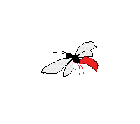
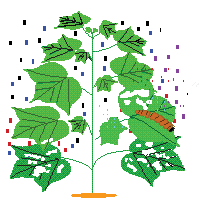
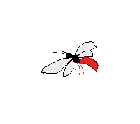



















chAPter 8 soil health, Plant health, and Pests
Plant gives off signals to attract
beneficials that attack pests
2
Plant increases extrafloral
nectar flow as food for
3
adult beneficials
1
Plant produces chemicals that slow pest feeding
Figure 8.2. Plants use a number of defense strategies following damage by feeding insects. Modified from unpublished slide of W.J. Lewis.
corn varieties and is, therefore, available for reintroduc-
system. The resistance is called systemic because the
tion into U.S. corn varieties.
entire plant becomes resistant to a disease, even far
Plants also have defense systems to help protect
away from the site where the plant was stimulated.
them from a broad range of viral, fungal, and bacterial
There are two major types of induced resistance:
attacks. Plants frequently contain substances that inhibit
systemic acquired resistance (SAR) and induced
a disease from occurring whether the plant is exposed to
systemic resistance (ISR) (figure 8.3). SAR is induced
the disease organism or not. In addition, antimicrobial
when plants are exposed to a disease organism or even
substances are produced when genes within the plant
some organisms that do not produce disease. Once
are activated by various compounds or organisms—or
the plant is exposed to the organism, it will produce
a pest—in the zone immediately around the root (the
the hormone salicylic acid and defense proteins that
rhizosphere) or by a signal from an infection site on a
protect the plant from a wide range of pests. ISR is
leaf. This phenomenon is called “induced resistance.”
induced when plant roots are exposed to specific plant
This type of resistance causes the plant to form various
growth–promoting rhizobacteria (PGPR) in the soil.
hormones and proteins that enhance the plant’s defense
Once the plants are exposed to these beneficial bacteria,
79
Building SoilS for Better CropS: SuStainaBle Soil ManageMent

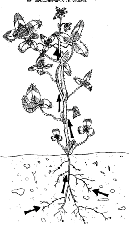



















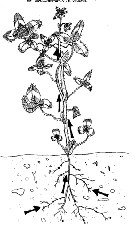




















chAPter 8 soil health, Plant health, and Pests
determine whether a soil amendment or soil is enhanc-
PLAnt defense MechAnIsMs
ing a plant’s defense mechanisms. More research needs
Plants are not passive in the face of attack by insects,
to be conducted before induced resistance becomes
nematodes, or diseases caused by fungi and bacteria.
a dependable form of pest management on farms.
Genes activated when plants are attacked or stimu-
Although the mechanism works very differently from the
lated by organisms produce chemicals that
way the human immune system works, the effects are
• slow insect feeding
similar—the system, once it’s stimulated, offers protec-
• attract beneficial organisms
tion from attack by a variety of pathogens and insects.
• produce structures that protect uninfected sites
When plants are healthy and thriving, they are
from nearby pathogens
better able to defend themselves from attack and may
• produce chemicals that provide a degree of resis-
also be less attractive to pests. When under one or more
tance to pathogenic bacteria, fungi, and viruses
stresses, such as drought, nutrient limitations, or soil
compaction, plants may “unwittingly” send out signals
hormones (jasmonate and ethylene) are produced that
to pests saying, in effect, “Come get me, I’m weak.”
protect the plants from various pests. Some organic
Vigorous plants are also better competitors with weeds,
amendments have been shown to induce resistance in
shading them out or just competing well for water and
plants. Therefore, farmers who have very biologically
nutrients.
active soils high in organic matter may already be tak-
Many soil management practices discussed in this
ing advantage of induced resistance. However, there
chapter and the other chapters in part 3 help to reduce
currently are no reliable and cost-effective indicators to
the severity of crop pests. Healthy plants growing
The plant defense
proteins provide de
jasmon
resistance to a p f
r ense
Plant growth–
oteins
variety of plant
ate
promoting
pathogens.
Plant hormones
rhizobacteria (PGPR)
jasmonate and
stimulate plant roots,
ethylene
causing production of
sali
ethylene increase
An increase in the
c
defense hormones.
acidylic
throughout the
hormone salicylic acid
plant and induce
causes the plant to
resistance to a
produce many types of
Disease organisms
wide variety of
defense proteins.
and nonpathogenic plant pathogens.
microbes stimulate
the plant above
or below ground
to produce the
hormone salicylic acid.
a) systemic acquired resistance (SAR)
b) induced systemic resistance (ISR)
Figure 8.3. Types of induced resistance to plant diseases. Modified from Val ad and Goodman (2004) by Amanda Gervais.
80
Building SoilS for Better CropS: SuStainaBle Soil ManageMent
chAPter 8 soil health, Plant health, and Pests
on soils with good biological diversity can mount a
strong defense against many pests. For examples of
MAnAGInG soILs And croPs to
the effects of soil management on plant pests, see the
MInIMIze Pest ProbLeMs
box on the right. The issue of plant health is so criti-
It is well established—and known by most farmers—that
cal to ecological soil and plant management because
crop rotation can decrease many disease, insect, nematode,
it also influences, as we have just seen, the ability of
and weed pressures. A few other examples of management
practices that reduce pest pressure follow:
plants to resist pests. Developing optimal soil health is,
therefore, the basis for management of crop pests on
• Insect damage can be reduced by avoiding excess inorganic
nitrogen levels in soils by using better nitrogen management.
farms—it should be a central goal that underpins crop
integrated pest management (IPM) programs.
• Adequate nutrient levels reduce disease incidence. For
example, calcium applications have reduced diseases in
EcOlOgIcAl PRINcIPlES FOR AgRIcUlTURE
crops such as wheat, peanuts, soybeans, and peppers, while
added potassium has reduced the incidence of fungal
Approaching agriculture and soil management from an
diseases in crops such as cotton, tomatoes, and corn.
ecological point of view means first understanding the
• Damage from insect and disease (such as fungal diseases of
characteristics that comprise strong natural systems.
roots) can be decreased by lessening soil compaction.
Let’s take a look at overall strategies that can contrib-
• Severity of root rots and leaf diseases can be reduced with
ute to similar strength of crops, animals, and farms.
composts that contain low levels of available nitrogen but
Then we’ll briefly discuss practices that contribute to
still have some active organic matter.
creating vital and strong agricultural systems (dis-
• Many pests are kept under control by having to compete
cussed in more detail in later chapters).
for resources or by direct antagonism from other insects
Ecological crop and soil management practices can be
(including the beneficials feeding on them). Good quanti-
grouped under one or more of three overall strategies:
ties of a variety of organic materials help maintain a diverse
• grow healthy plants with strong defense capabilities
group of soil organisms.
• stress pests
• Root surfaces are protected from fungal and nematode at-
• enhance beneficial organisms
tack by high rates of beneficial mycorrhizal fungi. Most cover
These overall strategies are accomplished by
crops help keep mycorrhizal fungi spore counts high and
promote higher rates of infection by the beneficial fungi.
practices that maintain and enhance the habitat both
above ground and in the soil. Ecological approaches
• Parasitic nematodes can be suppressed by selected cover
crops.
call for designing the field and farm to take advantage
of the inherent strengths of natural systems. Most of
• Weed seed numbers are reduced in soils that have a lot of
biological activity, with both microorganisms and insects
this is done prior to, and during, planting a crop and
helping the process.
has the goal of preventing problems from develop-
• Weed seed predation by ground beetles is encouraged
ing by contributing to one or more of the three overall
by reduced tillage and maintenance of surface residues.
strategies. However, there are also routine management
Reduced tillage also keeps the weed seeds at the surface,
practices that occur during the season even if you have
where they are accessible to predation by other organisms,
done a lot of preventive management. For example,
such as rodents, ants, and crickets.
irrigation is frequently needed for high-value crops such
• Residues of some cover crops, such as winter rye, produce
as fresh market vegetables—even in humid regions.
chemicals that reduce weed seed germination.
Also, scouting for pest problems and beneficials should
81
Building SoilS for Better CropS: SuStainaBle Soil ManageMent
chAPter 8 soil health, Plant health, and Pests
stronG ecosYsteM chArActerIstIcs
Efficiency. Efficient energy flows are characteristic of natural systems. The sun’s energy captured by green plants is used by many organisms, as fungi and bacteria decompose organic residues and are then fed upon by other organisms, which are themselves fed upon by others higher up the food web. Natural ecosystems also tend to be efficient in capturing and using rainfall and in mobilizing and cycling nutrients. This helps to keep the ecosystem from “running down” because of excessive loss of nutrients and at the same time helps maintain the quality of the groundwater and surface waters. Rainfall tends to enter the porous soil, rather than run off, providing water to plants as well as recharge to groundwater, slowly releasing water to streams and rivers.
Diversity. High biological diversity, both above ground and in the soil, characterizes many natural ecosystems in temperate and tropical regions. It provides nutrients to plants, checks on disease outbreaks, etc. For example, competition for resources and specific antagonisms (such as antibiotic production) from the multitude of soil organisms usual y keep soilborne plant diseases from severely damaging a natural grassland or forest.
Self-sufficiency. A consequence of efficiency and diversity in natural terrestrial ecosystems is that they become self-sufficient—requiring only inputs of sunlight and rainfal .
Self-regulation. Because of the great diversity of organisms, outbreaks (or huge population increases) of diseases or insects that severely damage plants or animals are uncommon. In addition, plants have a number of defense mechanisms that help protect them from attack.
Resiliency. Disturbances, such as climate extremes, occur in all ecosystems—natural or not. The stronger ones are more resistant to disturbances and are able to bounce back more quickly.
—ModiFied FroM MagdoFF (2007).
be part of routine management during the season. If an
and soil management is to minimize the extent of reac-
unanticipated problem, such as an insect outbreak, arises,
tive management (which reacts to unanticipated occur-
remedial action, such as applying the most ecologically
rences) by creating conditions that help grow healthy
sound pesticide or releasing purchased beneficials into
plants, promote beneficials, and stress pests. The discus-
the field, may be required to save the crop.
sion below and in the rest of this book focuses on ways
Ecological principles provide a good framework
to maintain and enhance habitat in order to promote
for sustainable management, but we must also recog-
one or more of the three strategies listed above.
nize that crop production is inherently an “unnatural”
process because we favor one organism (the crop plant)
EcOlOgIcAl cROP AND SOIl MANAgEMENT
over the competing interests of others. With currently
We?



































































